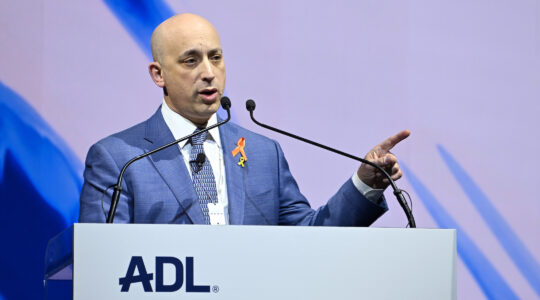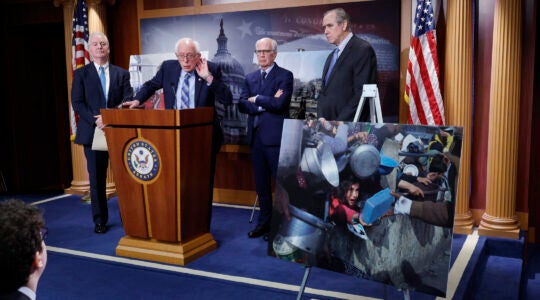NEW YORK (JTA) – When the Jewish Federations of North America sent out a news release last week promoting the top speakers at this year’s General Assembly, not a single woman made the list.
The oversight caught the eye of critics.
“Can it really be that the largest meeting of the organized Jewish community in North America can’t find a single female to put in its official announcements?” Forward newspaper editor Jane Eisner wrote in a blog post. “At a time when women remain sorely missing from the American Jewish establishment leadership, this oversight is telling.”
In fact, however, half of the VIP speakers at the General Assembly will be women, and 43 percent of all slated speakers at the conference, which begins next Sunday in Denver, are women.
The snafu over the speakers embodies both the gains made by the federation system on women’s issues in the past year or two, as well as the distance it still has to go.
“There was recognition that we weren’t where we need to be, and we’re getting there,” said Joe Berkofsky, the Jewish Federations’ managing director of communications and media relations.
Only two years ago, when Jerry Silverman was brought on as the new CEO and president of the Jewish Federations — then still called the United Jewish Communities — not one of the 20 largest federations was led by a woman. Women were underrepresented at GA programs, and the Jewish Federations allowed new mothers only up to 10 weeks of maternity leave, or 12 for a Caesarean section. The five finalists chosen in last year’s Jewish Community Heroes contest by a panel of 11 male judges and six female judges were men.
The federation is hardly alone in its record on women’s issues. A survey published by the Forward in 2010 found that only nine of the 75 largest Jewish organizations were led by women. In 2009, the number had been 11.
“It’s no secret that federations specifically, and the Jewish nonprofit world generally, reflected the greater culture,” Berkofsky said. “There was a gap between women’s advances in society and what is happening in the workplace.”
The federations have made it a priority to close that gap, Berkofsky said.
In May, the federation held its first conference for professional federation women, attracting 75 female federation executives, fundraisers, vice presidents and marketers to network and discusses strategies and obstacles that might impede their careers.
Last December, the Jewish Federations expanded paid maternity leave to up to 12 weeks for three-year employees. The organization took a step toward family friendliness by extending paternity leave for fathers and adopted parents to one month from five days. New policies also allowed employees to create more flexible schedules and telecommute more easily. An earlier policy, ended in 2005, had docked 5 percent of daily pay for each day worked from home.
“Our position has been that women are affected disproportionally by unfair workplaces,” said Shifra Bronznick, the president of Advancing Women Professionals and the Jewish Community, which promotes female leadership in Jewish communal organizations. “They had no good policies.”
Shortly after Silverman took office, she called him and said, “I have three things to tell you: women, flexibility policies, social justice.”
A year-and-a-half later, Bronznick says, there have been marked improvements to the federations’ culture.
The federation made sure that the panel of judges for this year’s Jewish Heroes contest was equally split between genders.
Aside from the workplace policy changes at the national umbrella organization, a growing number of women have been appointed to leadership roles. Seven of the 14 senior managers at Jewish Federations now are women, and the chair of the board of trustees, Kathy Manning, is a woman.
In the last year, 11 federations across the United States have hired women for their top positions, expanding the number of female federation CEOs to a record 50 out of 157 in North America.
“We wanted to make sure that federations are places where Jews, and Jewish women specifically, want to work,” Berkofsky said.
Jennifer Gorovitz, became the first head of a big-city federation in May 2010, at the Jewish Community Federation of San Francisco, Marin and Sonoma Counties. In August, Deborah Corber was appointed executive of Montreal’s federation CJA.
Putting more women at the top isn’t simply a matter of righting historical imbalances but of making sure the talent pool is not halved by eliminating women, and finding people with qualities federations might lack, say federation officials and activists.
“From a volunteer perspective, when women are in leadership positions they bring people to the table in a different way,” said Susan Kramer, who in January was appointed the CEO and president of the Jewish Federation of Greater Dallas.
Federation officials attribute the growing number of female leaders to a greater willingness to look outside the federation system for talent, as well as improvements in training and supporting female leaders already in the system.
With a significant portion of federation leaders expected to retire within the next few years, this decade will be critical, according to Manning, the chairwoman of the Jewish Federations.
“There will be big jobs opening up across the country,” she said. “It is a chance for well-qualified women to step into those positions.”
Bronznick worries that despite the improvements, parts of the federation world remain resistant to promoting women.
“In the federation world they tend to say that women don’t want these jobs,” she said. “These organizations have to see themselves as talent spotters and cultivators, and setting people up for success.
“They need to be change agents,” Bronznick added, “and I don’t see that happening at the level of intensity that current conditions require. I think people are looking towards incremental change, and I think we need fundamental change.”
JTA has documented Jewish history in real-time for over a century. Keep our journalism strong by joining us in supporting independent, award-winning reporting.





